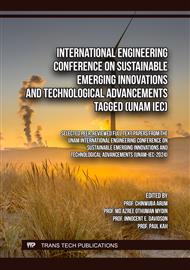p.37
p.47
p.57
p.71
p.87
p.99
p.113
p.123
p.133
Physical Modeling of Smart Monitoring Systems for Sustainable Water Distribution in Ongwediva Town
Abstract:
Water distribution systems are critical to urban infrastructure, especially in regions facing water scarcity. This study focuses on the design of an innovative water distribution system with smart monitoring for Ongwediva Town in Namibia, addressing challenges due to population growth and climate variability. By integrating advanced sensors and smart technologies, the system measures real-time water level and monitors flow rate, thereby reducing water loss and operational costs. Calculations for key components, including the ultrasonic water level sensor, critical buckling load, pump size, and photovoltaic (PV) requirements, are presented. The water level sensor provides accurate distance measurements based on ultrasonic pulse timing, while the flow rate sensor achieves a calibrated flow of 1.2 l/min. Structural analysis of the water tower support yields a moment of inertia of 5.33×10-9 m4, and a critical buckling stress of 1.37E×10-7 N/m2, confirming the suitability of mild steel. A 30 W pump powered by a 100 W PV system ensures reliable operation with minimal energy consumption. The daily energy requirement of 240 Wh and the adjusted requirement of 300 Wh highlight the importance of considering system efficiency in energy calculations. Accounting for a system efficiency of 80% ensures that the solar power system is adequately sized to meet operational demands without running into energy shortfalls. The system’s real-time data transmission allows for proactive leak detection and optimized water management, significantly improving sustainability. Testing and calibration confirm the system's reliability, offering a scalable model for other municipalities.
Info:
Periodical:
Pages:
87-96
Citation:
Online since:
November 2025
Price:
Сopyright:
© 2025 Trans Tech Publications Ltd. All Rights Reserved
Share:
Citation:


